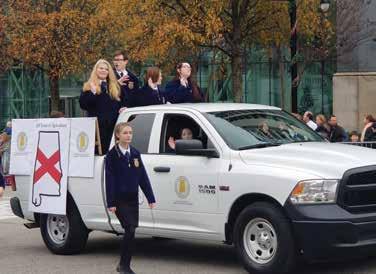
4 minute read
FFA Sentinel
Alabama FFA Participates in the Alabama Bicentennial Parade and Looks to the Future
Two hundred years as a state, wow! Alabama has seen a lot of change in that time. Agriculture has seen a lot change in that time. Alabama became part of the union on Dec. 14, 1819, and it is only fitting that we celebrate this occasion on Dec. 14, 2019.
Advertisement
Agriculture has always been a part of the economy of Alabama even before it was a territory. Native Amer icans practiced techniques such as slash and burn agriculture. This is a practice where forests were cleared to make room for patches of corn, squash and other crops. The Spanish recorded the savannahs found as they traveled north, remains of the agrarian society who left it. As more immigrants made their way into Alabama, they found varying soil types suited to a variety of different crops. Alabama’s waterways provided a means of getting crops to markets. With the 1700s came a great revolution for both agriculture and industry. With the desire for cotton, agriculture drove industrial improvements. By 1906, John Deere took his plow’s success and began developing steam-powered tractors. Production soared and crops were shipped by rail and barge.
Just think about where we are now. Cattle in 67 counties, leaders in the nation in poultry and forest products, peanuts, catfish, with over 9 million acres
26 Cooperative Farming News in Alabama considered farmland and cash receipts of over 5 billion dollars. Agriculture is still a viable in dustry and the good news of our industry should be shared with our citizens. It is true that in this day and age agriculture is more than farming, but in farming alone we are seeing GPS and GIS in self-driven equipment, computers calculating and projecting yield variations in crop land, advances in animal health, pesticide and herbicide use, and so much more on the way. Look how far we have come.
Agriculture education has changed and is changing as well. To meet the needs of industry and labor market demands of our state and continue to educate students and parents about traditional production, agriculture is sometimes a balancing act. New courses are in development for agriscience teachers to implement in the 2020-2021 school year focusing on areas such as animal science, veterinary science, poultry science, forestry and environmental management, aquaculture, food science and plant biotechnology to name a few. With our governor’s goals for workforce development related to post-secondary attainment for in-demand career pathways leading to valuable, portable post-secondary degrees, certificates and credentials; and adding 500,000 highly skilled workers to our workforce by 2025,

FFA State Sentinel Garrett Springs and Central District Secretary Case Edwards are all smiles and waves representing Alabama FFA and 200 years of Alabama’s statehood.
how does agriculture education play a role? Previously mentioning new and improved science-based agricultural courses and realizing that our labor market, especially in urban centers, is focusing on technology and manufacturing, how can agriculture contribute to this quickly growing sector? Have you ever heard the saying, “Agriculture is more than cows, plows and sows”? If you haven’t, you have probably not run into an FFA member or agriculture teacher in a while.
Having said that, agriculture education and FFA pre pares students for a multitude of careers. Alabama is also traditionally considered an agricultural mechanics state. This means that as part of agriculture education students are being taught skills that lead to careers in engine repair, welding, carpentry, electricity and courses are in development to contribute to skills more directly

Alabama FFA members march in the Alabama Bicentennial Celebration Parade.

Wetumpka FFA members along with their advisor Mr. William Norris march down Decatur Ave. to celebrate the 200th year of Alabama as a state.
focused on agricultural industry maintenance. These careers will help guide students to careers in which they can attain post-secondary credentials and contribute to the governor’s goals and our skilled workforce. These courses offer options to students to discover pathways in which to further their skills and knowledge leading to college or the workforce. The most beautiful part of agriculture education is that it offers such a variety to students and can help them decide what they are inter ested in before graduation and discover a true lifelong passion. Research shows that students who are part of career and technical education class in high school are more likely to graduate.
Continuing that celebration of 200 years, Alabama FFA was represented in the bicentennial parade by FFA State and District Officers as well as members from the Tallassee and Wetumpka FFA chapters. These FFA members and advisors were special guests of the Alabama Department of Agriculture and Industries and Commissioner Rick Pate.
“We were grateful for another opportunity to partner with those in our industry and appreciate the invitation to be part of this celebration,” said Garrett Springs, Alabama FFA Sentinel.
Each citizen contributes to the agriculture industry, whether they know it or not. The leadership and essential soft skills obtained in agriculture education and FFA also adds to the shine of the students and members furthering their ability to be trained and employed in the occupations Alabama has to offer. For more information about agriscience education and FFA in Alabama or to find out how you can support the Alabama FFA Association, please visit www.alabamaffa.org.





